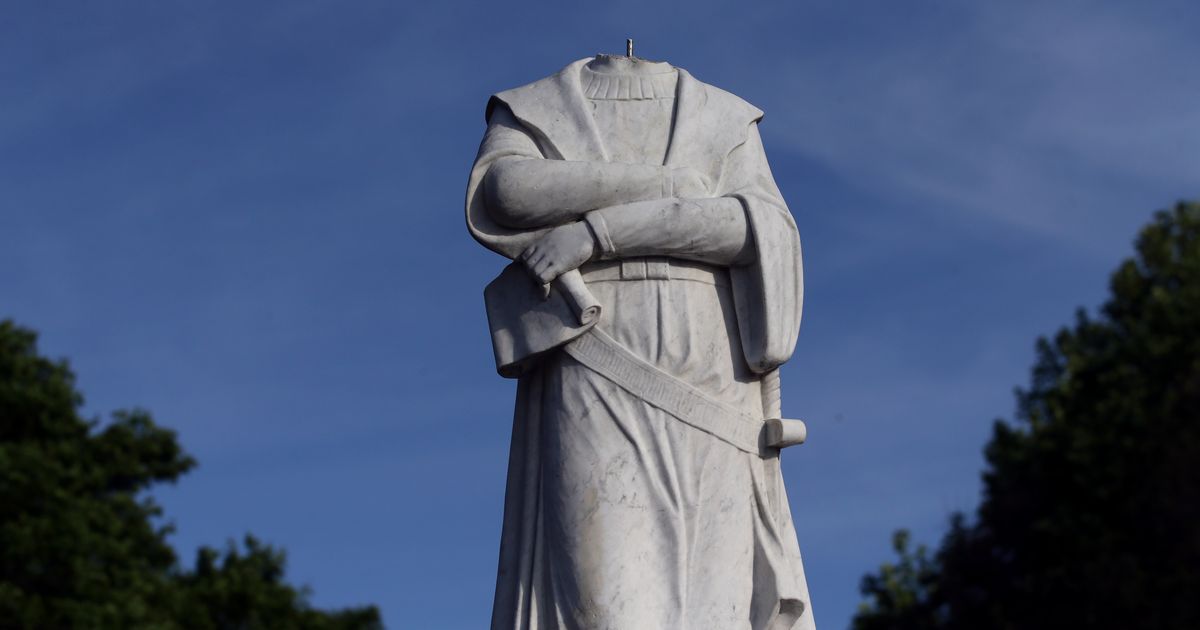As protests inspired by the Black Lives Matter movement continue, people across the country are calling for the removal of statues of known slaveholders and other racist figures.
In response to the death of George Floyd, a Black man who was killed by a white police officer kneeling on his neck for nearly nine minutes, protests against police brutality and systemic racism have erupted around the world. From rallying around Black victims of police violence to exposing abusive and racist work environments, we are living through a societal upheaval against racism in nearly every form. Part of that reckoning involves acknowledging that many historical figures, regardless of their legacies, were downright racist.
Some cities have begun voluntarily taking down statues whose presence glosses over a brutal history of slavery and genocide.
The city of Camden, New Jersey removed a statue of Christopher Columbus on Thursday night, ahead of a planned demonstration for the weekend. In Albany, New York, Mayor Sheehan ordered the removal of a statue of Philip Schuyler, a slaveowner who fought in the American Revolution and served in the early U.S. Senate. Last week, the governor of Virginia announced plans to remove a statue of Confederate General Robert E. Lee, and the Richmond City Council unanimously voted to remove four other Confederate statues on city property.
But in other places, where lawmakers aren’t taking the steps to remove the statues, people are protesting by defacing them and, in some cases, taking them down themselves.
In Richmond, Virginia, absolute kings protesters tore down not only a statue of Christopher Columbus, but also one of Confederate president Jefferson Davis. Another statue of the explorer, whose “discovery” of South America led to the genocide and forced migration of hundreds of thousands of indigenous people, was beheaded in Boston, Massachusetts. In Saint Paul, Minnesota, just miles from where George Floyd was killed, members of the American Indian Movement toppled a statue of Columbus, sang a traditional song, and then danced around the fallen figure.
It was a stunning scene.
The statue of the former president of the confederacy Jefferson Davis has been ripped down in Richmond https://t.co/qGb1hj0Dag
— Adam Parkhomenko (@AdamParkhomenko) June 11, 2020
Community activists have been advocating for the removal of statues long before this upheaval. Petitions to remove the statue at New York’s eponymous Columbus Circle have been circling for years, and a recent Change.org petition has over 3,000 signatures as of Friday. Governor Andrew Cuomo is against its removal and during a press conference Thursday, said the controversial figure represented “appreciation for Italian American contribution to New York.” The NYPD has been standing guard around the statue since Thursday.
It’s worth noting that the Columbus never set foot in North America, let alone modern day New York City.
When lawmakers don’t listen, angry constituents begin taking matters into their own hands. So if one did want to remove a racist statue, how would one safely take it down?
Legally, of course, I cannot encourage you to commit crimes or vandalize public property, even if said property represents some very grisly history. But if you were to hypothetically come across a statue that was in need of removal, here’s a purely informational thread that would allow you to imagine a scenario in which you safely took it down.
“The most important thing people need to realize is, to the extent possible, [they should be] putting pressure on city governments to remove them safely using mechanical equipment,” Egyptologist and archaeologist Sarah Parcak told Mashable in a phone call. “This is serious.”
With over 20 years of field experience, Parcak is familiar with the ways ancient civilizations erected and moved massive objects. She and her colleagues often work with the people of Qift, a town in Egypt just north of Luxor, where ancient pharaohs ruled from what was then known as Thebes. Many of the practices that people used thousands of years ago, Parcak said, are still used by people from Qift to help archeologists safely take down and move massive artifacts.
In a now-viral Twitter thread, Parcak compiled this handy list of ways to safely remove an obelisk that “might be masquerading as a racist monument.”
Though she stressed the importance of going to local governments first, she did acknowledge that sometimes, requests will fall on deaf ears.
For one, chains, not rope, will make this process a bit easier. And for safety’s sake, everyone involved in this takedown should wear gloves. Parcak also emphasized the importance of maintaining enough distance between the group and the statue, as a protestor in Portsmouth, Virginia was already gravely injured when a falling statue hit him.
PSA For ANYONE who might be interested in how to pull down an obelisk* safely from an Egyptologist who never ever in a million years thought this advice might come in handy
*might be masquerading as a racist monument I dunno
— Sarah Parcak (@indyfromspace) June 1, 2020
After assembling your group of protesters, wrap the chain around the top end of the statue and let it drape with enough slack on both sides. You’ll want roughly 40 people for a 20-foot tall statue, Parcak wrote.
Here’s the fun part: Once everyone is assembled, gloved up, and most importantly, a safe distance away from the monument, queue up an upbeat song and start pulling. Parcak said that a rhythmic song would work best, with one person on loudspeaker directing the two groups to pull toward themselves. To gain enough momentum to actually topple a monument of, say, Christopher Columbus, the group will have to have coordinate pulling left, right, left, right until the monument begins wobbling. Parcak compared it to a “paused tug of war.”
As soon as the “obelisk” begins to topple, get the fuck out of the way and commence celebrations.
Here’s a rough schematic. I note this is experimental archaeology in action! Just my professional Hot Take and you may need more people, longer rope, etc. everything depends on monument size. pic.twitter.com/lzl55CSPNt
— Sarah Parcak (@indyfromspace) June 1, 2020
“They just exist to brutalize Black people. These are monuments that signify white supremacy. Period. The End. There’s no other meaning to them.”
As an archaeologist, Parcak firmly believes that Confederate statues and other depictions of history’s vile racists belong in museums, not in public spaces.
“They need to be contextualized and there’s no context when they’re out in the open,” Parcak affirmed. “They just exist to brutalize Black people. These are monuments that signify white supremacy. Period. The End. There’s no other meaning to them.”
If you’re not in the mood for a spur of the moment revolution, there are ways to take down monuments to history’s problematic figures that are far more legal — if slightly more time-consuming.
The best way to start is by joining a group that advocates for the removal of racist statues. Check your local community Facebook groups. Can’t find any? Rally your neighbors and start one!
Once you’ve established a group, reach out to your local lawmakers — from the city council, to state representatives, to your governor. You can find your representatives on Common Cause.
You can also start and sign petitions to have racist statues taken down, and vote for representatives who incorporate taking down these statues in their campaign platforms.
Finally, constituents can call into public comment sessions for their local representatives and voice their concerns about allowing a monument that glorifies the dehumanization of marginalized people to continue standing in their communities.
How will archaeologists see these fallen statues a hundred years from now? A thousand years from now? Parcak hopes that this is “the end of the Civil War.” While the Civil War, and slavery with it, did technically end in the 19th century, the oppression of Black people in this country has taken on many other forms. Between Jim Crow laws, deep-rooted systemic racism, and disproportionate police brutality against Black Americans, the end of slavery did not necessitate absolute freedom.
“I hope that’s what future archaeologists see, that this was the beginning of the end,” Parcak concluded. “And the beginning of a much more more inclusive and welcoming America, the grand vision that our founding fathers — who are hugely problematic on so many levels — but the great America that we’ve always imagined could be.”
So start those petitions and take it up with your city councils. But if all else fails — and you didn’t hear it here — bottoms up, baby.




